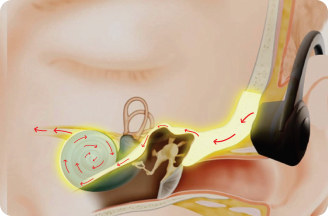Emergency Call
+91 9315366469Enquiry Us
audiologistamit@gmail.com▪️ Bone Conduction Uses temporal bone totransmit sound.
▪️ Temporal bone directly sends sound to cochlea bypassing eardrums and middle ears.
▪️ Cochlea sends sounds to brain through auditorynerve and person is able to hear.
Bone conduction technology works by transmitting sound through vibrations directly to the cochlea, bypassing the outer and middle ear. This process mimics how sound travels through a solid medium, making it especially beneficial for people with conductive or mixed hearing loss. Bone conduction hearing aids have gained popularity in recent years, particularly for their long-term ear health benefits. Since these devices don’t contact the ear canal, they present no risk of hearing loss, making them a preventative option.


Bone conduction technology traces its roots back to the 15th century when Italian physician Girolamo Cardano created the first bone conduction hearing aids. Cardano used the technique of attaching a tuning fork to a musical instrument while holding the other end in his teeth—a method later adopted by Beethoven. In the 1820s, French physician Jean-Marc Gaspard Itard improved on this technique by attaching the tuning fork to the mouth of another person, resulting in the creation of the “Rod of Itard.”
In the 1970s, a groundbreaking development in bone conduction technology occurred when Swedish doctors led by Anders Tjellstrom surgically implanted a vibration plate onto the mastoid bone. This vibration plate was connected to a processor that converted sound waves into vibrations, which were then transmitted directly to the inner ear. This invention became known as the Bone Anchored Hearing Aids (BAHA), providing a life-changing solution for individuals with hearing loss.
Today, bone conduction technology continues to evolve, with hearing aids and ear machines now available that don’t require surgery. Some hearing aids feature sound-processing units either attached to the device or in the form of wristbands, allowing individuals with hearing loss to benefit from bone conduction without invasive procedures.
In addition to offering solutions for those with hearing loss, bone conduction technology is also being developed to prevent hearing loss. Bone conduction audio devices are gaining popularity, especially among fitness enthusiasts participating in outdoor activities like marathons and cycling. These devices allow users to listen to audio while keeping their ears open, ensuring they remain aware of their surroundings.
Moreover, the technology has made significant contributions to the military, where soldiers use bone conduction audio devices for internal communication while staying alert on the battlefield. These devices are also being adopted by call centers, work-from-home employees, and corporate officials who frequently participate in calls and online meetings.
As bone conduction technology continues to advance, its applications are broadening. From hearing aids and ear machines to innovative devices preventing hearing loss, this technology is reshaping how we protect and enhance our auditory experiences.